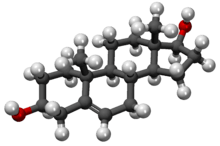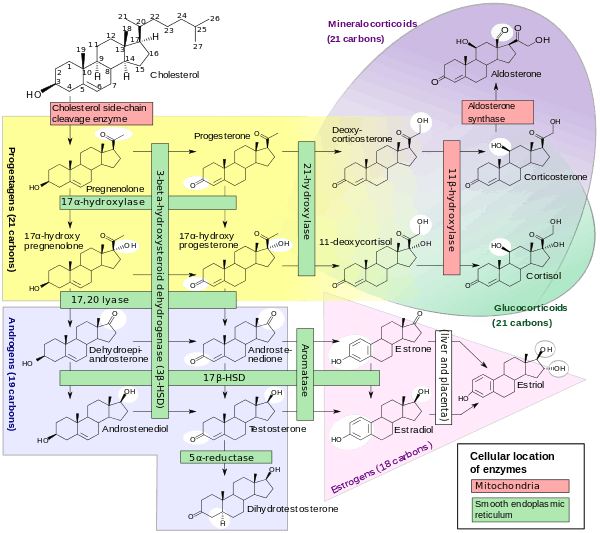5-Androstenediol
 | |
 | |
| Identifiers | |
|---|---|
| |
| CAS Number |
521-17-5 |
| PubChem (CID) | 10634 |
| ChemSpider |
10188 |
| UNII |
95PS51EMXY |
| ChEBI |
CHEBI:2710 |
| ChEMBL |
CHEMBL440283 |
| Chemical and physical data | |
| Formula | C19H30O2 |
| Molar mass | 290.44 |
| 3D model (Jmol) | Interactive image |
| |
| |
| (verify) | |
Δ5-Androstenediol (abbreviated as Δ5-diol), commonly referred to simply as androstenediol, and also known as androst-5-ene-3β,17β-diol, is an endogenous androgen and estrogen steroid hormone and intermediate in the biosynthesis of testosterone from dehydroepiandrosterone (DHEA).
Δ5-Diol is a direct metabolite of the most abundant steroid produced by the human adrenal cortex, DHEA. It is less androgenic than the related compound, Δ4-androstenediol, and has been found to stimulate the immune system. When administered to rats, Δ5-diol, in vivo, has approximately 1.4% of the androgenicity of DHEA, 0.54% of the androgenicity of androstenedione, and 0.21% of the androgenicity of testosterone.[1]
Δ5-Diol possesses potent estrogenic activity, similarly to DHEA and 3β-androstanediol.[2] It has approximately 6% and 17% of the affinity of estradiol at the ERα and ERβ, respectively.[3]
Use as radiation countermeasure
The value of Δ5-diol as a radiation countermeasure is based mainly on its stimulation of production of white blood cells and platelets.[4] Its potential use as a radiation countermeasure was introduced by the Armed Forces Radiobiology Research Institute (AFRRI) and subsequently studied by AFRRI and Hollis-Eden Pharmaceuticals under the tradename Neumune for the treatment of acute radiation syndrome.[4][5]
The clinical trials with rhesus monkeys was successful. According to the Hollis-Eden report, only 12.5% of the 40 Neumune-treated animals died versus 32.5% in the placebo group.[6]
Hollis-Eden had applied for a contract from the U.S. Government under the BioShield Request for Proposals (RFP) for radiation countermeasures. After being encouraged for 2.5 years that Neumune was in the competitive range, on March 9, 2007, the RFP was canceled by HHS. According to HHS, "the product was no longer in the competitive range".[7][8] No further explanation was given. As a result, Hollis-Eden has now withdrawn from the radiation countermeasure field.
Additional images

See also
References
- ↑ Coffey, DS (1988) "Androgen action and the sex accessory tissues". In E Knobil, J Neill (eds), The Physiology of Reproduction. Raven Press, New York, pp 1081-1119.
- ↑ Hackenberg, Reinhard; Turgetto, Inga; Filmer, Angelika; Schulz, Klaus-Dieter (1993). "Estrogen and androgen receptor mediated stimulation and inhibition of proliferation by androst-5-ene-3β,17β-diol in human mammary cancer cells". The Journal of Steroid Biochemistry and Molecular Biology. 46 (5): 597–603. doi:10.1016/0960-0760(93)90187-2. ISSN 0960-0760.
- ↑ Kuiper GG, Carlsson B, Grandien K, Enmark E, Häggblad J, Nilsson S, Gustafsson JA (1997). "Comparison of the ligand binding specificity and transcript tissue distribution of estrogen receptors alpha and beta". Endocrinology. 138 (3): 863–70. doi:10.1210/endo.138.3.4979. PMID 9048584.
- 1 2 Whitnall MH, Elliott TB, Harding RA, Inal CE, Landauer MR, Wilhelmsen CL, McKinney L, Miner VL, Jackson WE 3rd, Loria RM, Ledney GD, Seed TM (2000). "Androstenediol stimulates myelopoiesis and enhances resistance to infection in gamma-irradiated mice". Int. J. Immunopharmacol. 22 (1): 1–14. doi:10.1016/s0192-0561(99)00059-4. PMID 10684984.
- ↑ Grace MB, Singh VK, Rhee JG, Jackson WE 3rd, Kao TC, Whitnall MH (2012). "5-AED enhances survival of irradiated mice in a G-CSF-dependent manner, stimulates innate immune cell function, reduces radiation-induced DNA damage and induces genes that modulate cell cycle progression and apoptosis". J. Radiat. Res. 53 (6): 840–853. doi:10.1093/jrr/rrs060. PMID 22843381.
- ↑ Hollis-Eden Pharmaceuticals Reports Publication of Results Demonstrating the Ability of NEUMUNE(R) to Increase Survival in a Primate Model of Lethal Radiation Injury, February 26, 2007.
- ↑ Government Nukes Hollis-Eden's Radiation Drug, by Val Brickates Kennedy and Angela Moore, March 8, 2007
- ↑ US cancels radiation contract with Hollis-Eden, March 9, 2007
External links
- Regenerative Medicine - Official Hollis-Eden Pharmaceuticals website
- New Scientist article on AED as an anti-radiation sickness drug